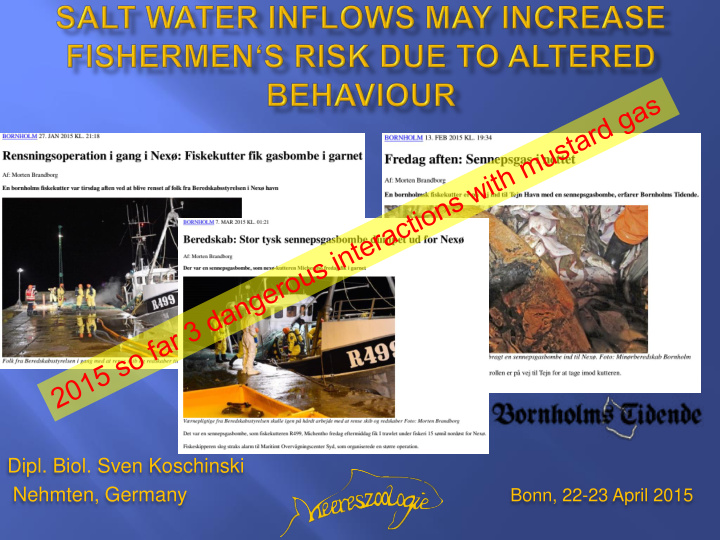



Dipl. Biol. Sven Koschinski Nehmten, Germany Bonn, 22-23 April 2015
32.000 tonnes of chemical warfare materials have been dumped northeast of Bornholm between 1945 and 1965
Thereby one of the most important cod spawning areas in the Baltic was contaminated with highly toxic materials such as sulphur mustard or arsenic containing agents (arsine oil, Clark I & II, Lewisite, Adamsite)
Today, the same area sustains a cod fishery with high commercial value. The main fishing gear used is the bottom trawl
Mustard gas is persistent in lumps and frequently caught by fishing vessels operating around Bornholm. Trawling and emergency redumping relocates warfare material. The contaminated area gets bigger.
30 etc. number of incidents (HELCOM reporting system) 25 tear gas Clark 20 Adamsite sulfur mustard 15 Large salt water inflow 10 (www.smhi.de) 5 0 1994 1995 1996 1997 1998 1999 2000 2001 2002 2003 2004 2005 2006 2007 2008 2009 2010 2011 2012
Large salt water inflow etc.
• Cod are dispersed and not present at the bottom in stagnation years • Salt water inflows produce favourable conditions for cod eggs Halocline • Cod are concentrated at and below halocline in inflow years • Fishermen fish at cod concentrations and use gear optimized for cod (i.e. bottom trawl) CHEMSEA: • CHEMSEA and MERCW studies Such inflows may lead to a re- done in stagnation phase when fish development of benthic fauna, on which fish like cod feed on, were not present close to the bottom creating a shortcut for pollutants into the food chain
Conclusions • Environmental effects of salt water inflows on chemical warfare not well studied • Side effects not studied (e.g. fishermen‘s behaviour) • Fishermen knowingly put themselves at a high risk • Catch loss compensation for Danish fishermen due to contamination may be a wrong incentive • High trawling activity further disperses chemical warfare • Fishing bans may result in a better protection of the environment, fishers and fish consumers • Work of HELCOM MUNI on chemical munitions must be continued Graphs taken from Hinrichsen et al. 2007, Storr-Paulsen et al. 2012, HELCOM 2013
Recommend
More recommend